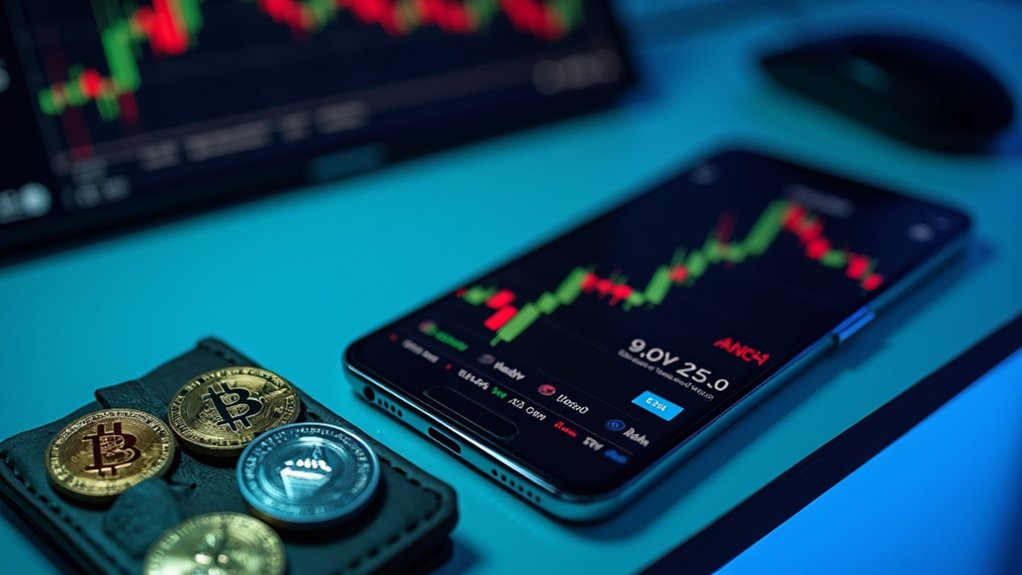Utilize trading in cryptocurrency enables investors to control larger positions than their initial capital would permit, typically through borrowed funds from exchanges. This mechanism, similar to margin trading in traditional markets, amplifies both potential profits and losses proportionally to the utilization ratio employed. While 10x-100x utilization facilitates strategies like shorting and scalping, it greatly increases liquidation risk during market volatility. Implementing strict risk management protocols, including strategic stop-loss orders and position sizing, remains essential for traders maneuvering this high-risk environment.

In the domain of cryptocurrency markets, margin trading has emerged like a powerful yet precarious financial mechanism that enables traders to boost their potential returns through borrowed capital. This practice, akin to leverage trading in traditional Forex markets, allows participants to control positions substantially larger than their initial investments would typically permit, thereby increasing both the potential profits and losses in direct proportion to the selected leverage ratio.
For instance, a trader deploying $1,000 with 10x leverage effectively commands a $10,000 Bitcoin position, transforming modest 1% price movements into significant 10% shifts in account equity, a phenomenon particularly attractive in cryptocurrency's characteristically volatile environment.
The operational framework of leverage varies across market segments, with distinct applications in spot trading versus derivatives contracts such as futures and options. Capital efficiency represents the primary advantage, enabling traders to maximize exposure while maintaining liquidity for diversified strategies across multiple assets.
This flexibility proves especially valuable for short-term tactics including scalping and day trading, where rapid execution and position scaling become vital performance factors. Additionally, leverage facilitates short-selling, allowing market participants to capitalize on anticipated price declines, a capability not fundamentally available in standard spot transactions. Most traders execute these strategies through centralized exchanges where order types like limit and stop-loss can be implemented efficiently.
Despite these advantages, leverage introduces substantial risks, most strikingly the specter of liquidation when asset prices move adversely, triggering margin calls that may terminate positions automatically. Most brokers typically set margin requirements at 25% to protect against excessive risk exposure. The cryptocurrency market's intrinsic volatility exacerbates this danger, particularly at higher leverage ratios such as 50x or 100x, where even minor price fluctuations can precipitate complete position liquidation. After the 2008 financial crisis, stricter regulations were implemented on margin trading in many jurisdictions to protect consumers.
Effective risk management strategies, consequently, become imperative, including judicious position sizing, strategic deployment of stop-loss orders, and preference for isolated margin configurations that prevent cross-collateralization risks.
Regulatory frameworks further complicate the leverage landscape, with jurisdictional variations imposing divergent restrictions on available ratios and trading conditions. Ultimately, while leverage trading offers remarkable potential for enhanced returns, it demands sophisticated understanding of market behaviors, disciplined execution, and thorough risk assessment protocols to navigate successfully.
Frequently Asked Questions
How Do I Calculate Liquidation Prices for Leveraged Positions?
Liquidation price calculation for borrowed positions requires determining the price at which margin falls below maintenance requirements.
For long positions, the formula is Entry Price × (1 – 1/Borrowing), while short positions use Entry Price × (1 + 1/Borrowing).
These calculations must account for maintenance margin rates, which vary by platform and position size, and are further affected by margin mode (isolated vs. cross), funding fees, and unrealized profits or losses.
What Is the Difference Between Cross and Isolated Margin?
Cross margin utilizes the entire account balance in the role of collateral across all positions, allowing shared risk and automated fund reallocation, while isolated margin reserves specific amounts for individual trades, limiting risk exposure.
With cross margin, positions interact financially, risking total account liquidation if multiple trades decline; isolated margin contains losses to allocated amounts, preserving the remainder of the portfolio.
Cross margin suits hedging strategies, while isolated margin provides predictable risk parameters for distinct positions.
Which Exchanges Offer the Highest Leverage for Bitcoin Trading?
According to the provided information, BTCC offers the highest margin for Bitcoin trading at 500x on futures contracts, followed by MEXC and BYDFi, both providing 200x margin.
Binance ranks third with 125x margin through perpetual futures contracts.
These high-margin platforms typically implement risk management tools, including automatic liquidation levels and maintenance margin thresholds, while restricting ultra-high margin to major cryptocurrency pairs like Bitcoin, Ethereum, and XRP.
Can Leverage Trading Affect Overall Market Volatility?
Utilizing trading considerably amplifies market volatility through several mechanisms, including liquidation cascades where forced selling during price movements triggers additional sell-offs.
When highly leveraged positions face margin calls, exchanges execute bulk liquidations, creating self-reinforcing downward momentum that exacerbates price swings.
Additionally, funding rate imbalances signal over-leveraged market sentiment, while reduced liquidity during extreme volatility leads to greater slippage and price gaps between liquidation zones and actual market prices, further destabilizing markets.
Are There Tax Implications Specific to Losses From Liquidations?
Losses from liquidations carry specific tax consequences, since they are treated as capital losses for tax purposes, with categorization depending on the holding period of the foundational assets.
Taxpayers must properly document these events on Form 8949 and Schedule D, including accurate cost basis calculations that incorporate initial margin, fees, and borrowed funds.
Unused capital losses may be carried forward to offset future gains, though wash sale rules apply differently compared to traditional markets, requiring careful consideration of repurchase timing.









